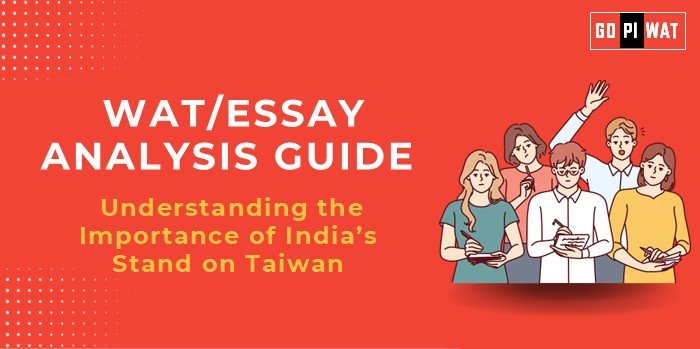📋 WAT/Essay Analysis Guide: Understanding the Importance of India’s Stand on Taiwan
🌐 Understanding the Topic’s Importance
India’s stance on Taiwan is a case study in strategic diplomacy. It offers lessons in balancing trade and technology aspirations with geopolitical complexities. For B-schools, this topic reflects critical decision-making at the intersection of business, economics, and international relations.
📝 Effective Planning and Writing
- Time Allocation:
- Reading & Planning: 5 minutes
- Writing: 20 minutes
- Review: 5 minutes
- Word Count Distribution:
- Introduction: 70 words
- Body: 360 words
- Conclusion: 70 words
✍️ Introduction Techniques
- Contrast Approach: “India’s Act East policy encourages deeper ties with Taiwan for economic and technological gains. However, this must be balanced against the geopolitical risks posed by China’s opposition.”
- Solution-Based Approach: “As global semiconductor demand surges, India’s engagement with Taiwan offers a pathway to economic diversification while safeguarding regional stability.”
- Historical Lens: “From adhering strictly to the ‘One China’ policy to nuanced economic engagement with Taiwan, India’s evolving stance highlights its adaptability in global diplomacy.”
📚 Structuring the Essay Body
Achievements:
- Highlight the growth in bilateral trade and its impact on India’s tech industry.
- Showcase Taiwan’s role as a leading semiconductor supplier and potential ally in India’s quest for technological self-reliance.
- Example: Discussions to set up semiconductor manufacturing facilities in India with Taiwan’s technical expertise.
Challenges with Comparative Analysis:
- Discuss risks like China’s economic and military retaliation, referencing similar global scenarios like US-Taiwan relations.
- Cite data on India’s economic dependency on China to illustrate the challenge of diversifying partnerships without provoking conflict.
- Example: India-China trade exceeding $135 billion in 2023, with a significant trade deficit.
Future Perspective:
- Advocate for enhanced informal ties, especially in non-controversial sectors like technology and education.
- Emphasize the importance of multilateral forums in de-escalating potential conflicts.
- Example: India’s participation in Quad discussions that indirectly support Taiwan’s democratic values.
🔗 Concluding Effectively
- Balanced Perspective: “India’s engagement with Taiwan, while cautious, exemplifies the delicate art of diplomacy. As it navigates these complexities, strategic pragmatism will ensure both economic growth and regional stability.”
- Global Comparison: “India’s approach to Taiwan mirrors that of Japan, blending economic collaboration with a commitment to maintaining regional peace.”
📊 Analyzing Successes and Shortcomings
Key Achievements:
- Trade growth and semiconductor partnership discussions.
- Establishment of cultural and educational ties.
- Strategic diversification of global alliances.
Ongoing Challenges:
- Navigating China’s aggressive stance on Taiwan.
- Addressing vulnerabilities in semiconductor supply chains during potential conflicts.
Global Context:
- Comparison with Australia and Japan’s balancing strategies with Taiwan and China.
- Lessons from global semiconductor supply chain strategies, including US and EU investments.
🔍 Recommendations for Sustainable Progress
- Strengthen Economic Ties: Focus on non-sensitive areas like technology, education, and culture to deepen ties without provoking diplomatic conflict.
- Diversify Supply Chains: Leverage Taiwan’s semiconductor expertise to reduce dependency on China for critical components.
- Engage in Multilateral Forums: Use Quad and other platforms to advocate for regional stability and shared economic interests.
🌟 Sample Short Essays
Balanced Perspective:
“India’s relationship with Taiwan reflects its pragmatic approach to international relations. Strengthening economic and technological ties without compromising its diplomatic stance on the ‘One China’ policy allows India to navigate complex regional dynamics while safeguarding its strategic interests.”
Solution-Oriented:
“Taiwan’s dominance in semiconductors provides India with an opportunity to secure critical supply chains for its burgeoning technology sector. By deepening informal ties, India can strengthen its economy while addressing geopolitical challenges with caution.”
Global Comparison:
“India’s nuanced engagement with Taiwan mirrors strategies adopted by nations like Japan. By fostering economic partnerships and respecting diplomatic sensitivities, India positions itself as a responsible actor in the Indo-Pacific while pursuing its national interests.”


